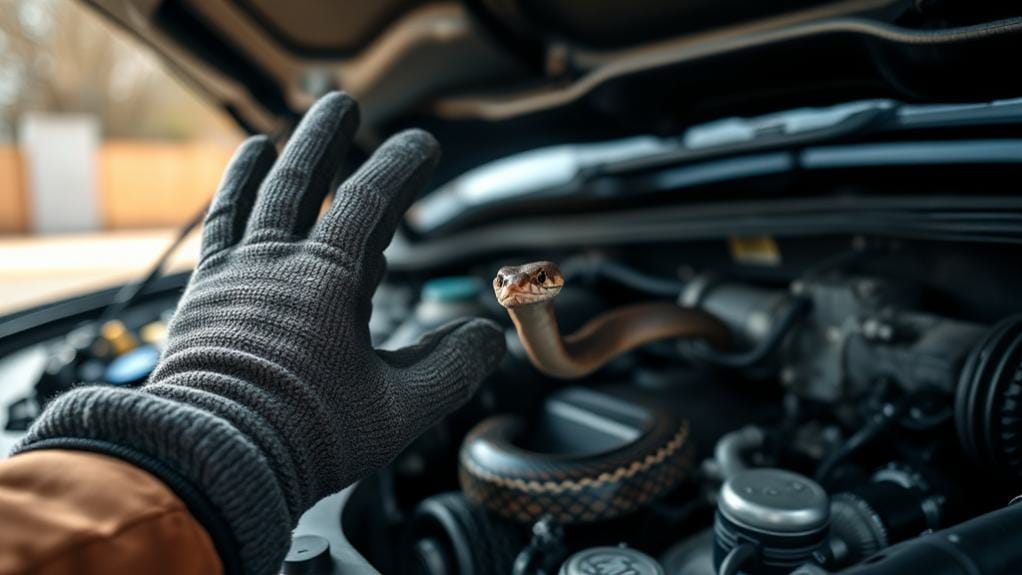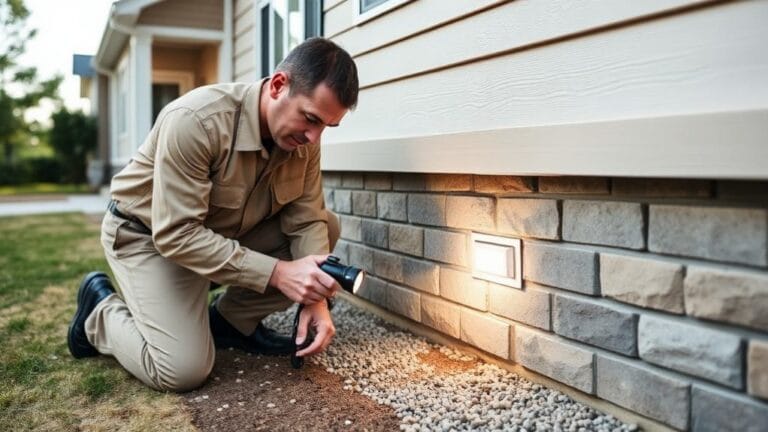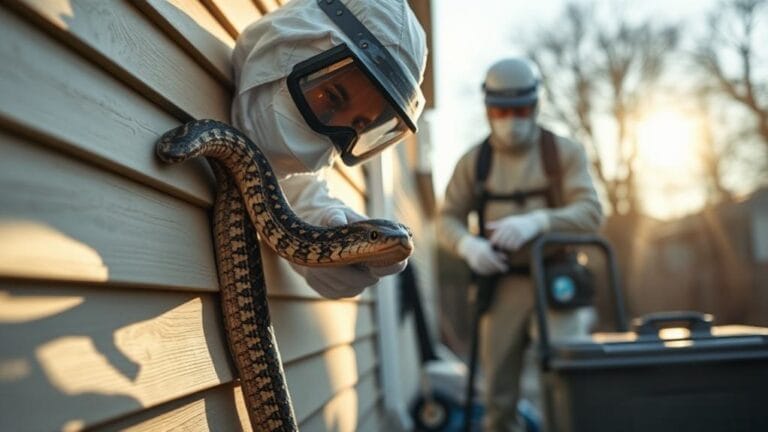Let's be real – finding a snake in your car engine isn't exactly how you wanted to start your day. Don't panic, but don't play hero either. First, keep your distance and assess if the snake looks aggressive. Try some basic tricks: honk your horn, let the engine cool down completely, or start the car briefly to create vibrations that'll make the snake want to leave. If these don't work, it's time to call the pros – animal control or a snake removal service. Never try to grab or kill the snake yourself. While you wait for help, keep kids and pets away. There's a lot more to know about preventing these scaly surprises.
Understanding Snake Entry Points
Table of Contents
The nightmare of finding a snake in your car engine often starts with understanding how these reptiles make their way inside.
Let's face it – your engine compartment is basically a luxury snake resort, complete with warmth and cozy darkness. Lucky you!
Snake repellent options like scent and noise-based deterrents can help keep these unwanted visitors away from your vehicle.
Here's how these unwanted guests typically invite themselves in:
- Through gaps in your engine bay (because apparently snakes don't need fancy doorways)
- Via ground-level openings when you're parked near bushes or debris
- From overhanging trees (yes, they can drop in like tiny reptilian paratroopers)
- Through open windows and doors (if you're really having a bad day)
*Pro tip: I always tell people to make their vehicle less snake-friendly by keeping doors and windows closed when parked.
Trust me – it's way easier than explaining to your mechanic why you're refusing to pop the hood.*
Immediate Steps for Snake Removal

Discovering a snake in your engine bay can trigger panic, but I've found that staying calm and following systematic steps gives you the best chance of resolving the situation.
While natural snake repellents like cedar oil and cinnamon can help prevent future encounters, immediate action is essential for engine bay incidents.
Let me walk you through the immediate actions you should take when there's a snake in your car. Trust me – no one wants an unwanted passenger hiding near their serpentine belt (pun intended).
Here are your go-to steps, in order of escalation:
- Honk that horn like you mean it! Snakes hate loud noises.
- Let the engine cool down completely – they might just slither away.
- Start the car briefly to create those snake-deterring vibrations.
- Pour some water in there to make things uncomfortable.
If these steps don't work, don't try to be a hero. Call animal control and let the professionals handle your scaly situation.
Safety Precautions When Encountering Snakes

When facing a snake in your engine bay, proper safety precautions become your lifeline between a close call and a potential emergency. I can't stress enough how important it is to keep your distance – yes, even if you're dying to snap that perfect Instagram shot of your unexpected visitor.
| Danger Level | What You See | What You Do |
|---|---|---|
| High Risk | Aggressive snake | Back away now! |
| Medium Risk | Snake starting to crawl | Maintain distance |
| Low Risk | Sleeping snake | Stay alert, call help |
| No Visual | Suspected presence | Keep hood closed |
Let's be real – your curiosity isn't worth a trip to the ER. Keep kids and pets away (because they're definitely not helping), and don't play hero by trying to remove the snake yourself. Pro tip: Those professional snake handlers? They're pros for a reason.
Your best move is staying calm and letting the experts handle this slithery situation.
Professional Help and Resources

Now that we've covered safety basics, let's talk about who to call when your engine bay becomes a snake's temporary home.
Let's be real – this isn't a DIY moment. You need professional help, and fast. While dark and secluded spots make car engines an attractive hiding place for snakes seeking warmth and shelter, professional removal is essential for everyone's safety.
Your best options for getting that unwanted passenger out of your car are:
- Local animal control – they've got the training and tools
- Professional snake catchers who know your area's species
- Wildlife removal services (check online reviews first!)
- Your trusted mechanic who can inspect for entry points
Don't try to be a hero. These professionals deal with similar situations daily and know exactly how to handle them safely.
While you're waiting for help to arrive, keep your distance from the vehicle and warn others to do the same.
*Pro tip: Save these numbers in your phone now – you'll thank me later if you ever need them.*
Prevention Tips for Future Encounters

After dealing with a snake in your engine, the last thing you'll want is a repeat performance. Let's make your car as snake-proof as possible with these no-nonsense steps. Getting a professional inspection service can help identify potential snake entry points around your vehicle.
First, close those doors and windows tight – every single time you park. I know it sounds obvious, but you'd be surprised how many people forget. Your car isn't a snake hotel!
Here's what else you need to do:
- Check your engine compartment regularly – snakes love warm, cozy spaces
- Park away from bushes and tall grass (yes, even if it means walking an extra 20 feet)
- Use snake repellent around your parking area
- Learn about local snake species (because knowledge is power, folks)
*Pro tip: Keep your engine bay clean and clear of debris. Snakes love nesting in that mess you've been ignoring.*
Engine Protection and Maintenance

Regular engine maintenance isn't just about keeping your car running – it's your first line of defense against unwanted serpentine visitors.
Much like common burrowing snakes such as the Florida Pine Snake and Bull Snake that seek warm shelter, your engine compartment can become an attractive haven.
Trust me, you don't want to discover a snake has made your engine its cozy winter retreat during your next oil change.
Here's your essential engine protection checklist:
- Check your engine compartment weekly – yes, weekly! Look for signs of unwelcome guests like shed skin or droppings.
- Seal any gaps around your engine bay – snakes are basically liquid and can squeeze through tiny spaces.
- Keep maintenance checks up to date – a well-maintained engine offers fewer hiding spots.
- Install protective mesh around vulnerable areas – it's cheaper than dealing with snake-related repairs.
*Pro tip: Park in open, well-lit areas away from bushes. Your engine's warm spots are like a five-star snake resort – don't make it too inviting!*
Frequently Asked Questions
What to Do if a Snake Gets in Your Car?
I'd stay calm and keep my distance from the snake. I'll try honking or starting my engine to scare it away. If that fails, I'll use a long pole carefully or call animal control for help.
Can a Snake Live in a Car Engine?
I'll tell you straight: a snake can live briefly in your car engine since it's warm and dark, but it won't survive long-term without food and water. It's really just a temporary shelter for them.
How to Get a Snake Out of a Car Interior?
I'd recommend staying calm and opening all doors. Use a long pole to guide the snake toward an exit, but don't make sudden moves. If you're uncomfortable, I'd call animal control for help.
Can a Snake Get Into Your Car While Driving?
I want you to know it's very unlikely a snake will enter your car while you're driving. However, if one's already hiding in your engine before you start driving, it could emerge during travel.
Last Word
Finding a snake in your engine isn't how anyone plans to start their day – I learned that the hard way last summer when my neighbor's pet python decided my Honda made the perfect vacation spot. Stay calm, call the pros, and remember: prevention beats panic every time. I've installed mesh screens and keep my garage snake-proof now. Trust me, you'll thank yourself for taking these precautions before you're staring down a serpent through your hood ornament.








